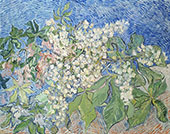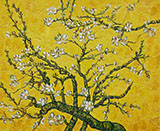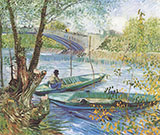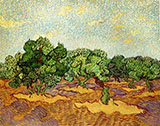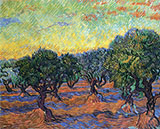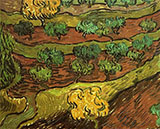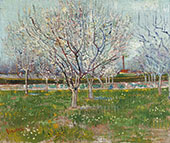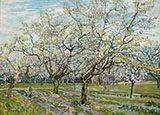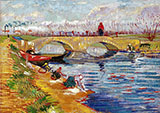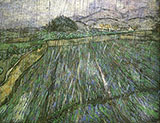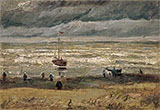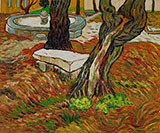Vincent van Gogh Oil Painting Reproductions
Vincent van Gogh replica paintings on Canvas for sale
Famous Paintings by Vincent van Gogh: An Artistic Biography
Born on 30 March 1853, Vincent Van Gogh is one of the most famous painters in the entirety of art. His striking colors, energetic brushwork, and beautiful compositions profoundly influenced a generation of artists to follow.
Given his worldwide renown and artistic importance, we explore Van Gogh’s captivating personal life through his famous paintings. Here are some of the most frequently asked questions about Van Gogh’s paintings and their fascinating stories.
Where was Van Gogh born?
Born in Groot-Zundert (the Netherlands), Van Gogh traveled across Europe as a young man. He journeyed through Belgium, France, and England before settling in London for three years.
Van Gogh saw inspiring art in London’s extensive public art galleries. Van Gogh’s brother, Theo (who worked in an art gallery), also introduced Van Gogh to the latest styles and ideas.
Van Gogh only decided to work as an artist at 27. Before this, he worked as a shop assistant, teacher, and Christian lay minister
What was Van Gogh's most famous painting?
In terms of famous paintings by Vincent van Gogh, Sunflowers (1889) is the best-known today. He made five separate versions of this painting, varying colors, and arrangements.
After Van Gogh saw Impressionist art in Paris (including paintings by Claude Monet and Camille Pissarro), he introduced brighter colors into his work. The result is increasingly extreme color contrasts in later sunflower paintings.
Indeed, Van Gogh’s early paintings (The Potato Eaters or Still Life with Bible, 1885) used incredibly dark palettes and are reflections of his study of Dutch painters, such as Rembrandt van Rijn and Frans Hals.
Van Gogh also used these famous sunflowers to decorate Gauguin’s room in Arles. Finally, Van Gogh invited Gauguin to stay with him in the hope that they could set up an artist’s colony. Arriving in October 1888, Gauguin only stayed for 63 days, however. He left after a series of explosive arguments with Van Gogh.
What is the story behind The Starry Night painting
Van Gogh Starry Night 1899 is one of the most recognizable paintings. Writing to his brother in June 1889, Van Gogh described a “new study of a starry sky.”
In other letters, Van Gogh described the “huge” morning star and the “wheat fields” visible from his bedroom window. This window was his room in the asylum at Saint-Rémy-de-Provence, where Van Gogh was a patient.
He spent days and nights simply gazing out of this east-facing window at the asylum. Despite lengthy periods observing the landscape, much of Starry Night is imaginary. Indeed, the dream-like village, the moon, and the cypress trees were all variations of reality.
What are Van Gogh's most famous paintings?
In addition to Sunflowers and Starry Night, famous paintings by Vincent van Gogh include works such as Irises and Night Café.
Paintings such as the Van Gogh Night Café (1888) demonstrate the artist's evolving style. Writing to his brother, Van Gogh described how he tried to express the “terrible passions of humanity” with the “blood red” walls and green billiard table.
Vincent van Gogh’s Irises (painted May 1889) is one of the artist's most beautiful and expensive works. It sold for $54 million at New York Sotheby’s on 11 November 1987.
Scholars believe it was the first painting Van Gogh created after entering the Saint-Paul de Mausole asylum. This breakdown resulted in Van Gogh severing his ear before voluntarily committing to the institution.
In addition to his striking landscapes, still lifes, and townscapes, Van Gogh is also well-known for his portraits. While he created several notable portraits of sitters such as Père Tanguy and The Postman Joseph Roulin, Van Gogh’s self-portraits are most famous today.
He once said portraits were the “only thing in painting” that “moves me deeply.” Indeed, Van Gogh’s self-portraits give a fascinating insight into his evolving painterly style and mental state. His Self Portrait with Bandaged Ear (painted shortly after his breakdown in Arles) is a truly iconic work.
Which Van Gogh painting is worth the most?
Van Gogh’s Portrait of Dr. Paul Gachet is the most expensive Van Gogh artwork. It set an impressive precedent for the artist, sold for $83 million on 15 May 1990. Indeed, in today’s money, this equals 180 million dollars.
The painting holds particular interest, as Dr. Gachet was an important individual in Van Gogh’s life. He cared for the artist after he shot himself in Auvers-sur-Oise, making Gachet one of the last people in Van Gogh’s company.
Purchased by a Tokyo buyer (the businessman Ryoei Saito), it also demonstrates the deep Japanese appreciation for Impressionist and Post-Impressionist art.
What are five interesting facts about Vincent van Gogh?
Here are five lesser-known facts about this artist’s fascinating life and work.
- Van Gogh liked a joke.
There’s a Van Gogh skeleton painting depicting a skull with a burning cigarette. He painted it as a juvenile joke while studying at Antwerp's prestigious art academy. While drawing skeletons formed part of the curriculum, painting them (with cigarettes) did not.
- Van Gogh only sold one painting.
Surprisingly, Van Gogh only sold one painting in his lifetime; Red Vineyard at Arles (sold for 400 Francs).
Van Gogh lived most of his life in poverty. As a young man, he worked as a religious missionary in Belgium, giving away all his possessions. It was only after his dismissal by church authorities (for causing scandals with his literal interpretations of Jesus’s life) that Van Gogh started painting seriously.
- Van Gogh’s nickname was the “Redheaded Madman.”
It’s common knowledge that Van Gogh suffered from mental health issues throughout his life. In addition, he experienced frequent poverty and malnutrition. As a result, he often experienced hallucinations, earning his nickname “le fou roux” amongst his neighbors in Arles.
- Van Gogh produced 43 self-portraits.
Van Gogh rarely had enough money to pay for models. He also had a limited social circle, often falling out with his few friends. Consequently, Van Gogh painted over 40 stunning self-portraits of the only model available, himself.
- Van Gogh painted over his art.
In 2022, art historians discovered a Van Gogh self-portrait hidden behind another painting, Head of a Peasant Woman.
As staggering as this discovery was, this was a regular cost-saving trick used by Van Gogh. He often painted over artworks instead of buying new canvases.
How many paintings did Van Gogh make before his death
Even though Van Gogh died at 37, he produced hundreds of oil paintings during his short career
He created almost 900 oil paintings and around 1,100 words on paper. Given that Van Gogh only took-up painting at the age of 27, it’s a truly astounding amount.
Van Gogh shot himself on 27 July 1890. He died from the infected wound two days later. Van Gogh’s poignant last words to his brother were, “the sadness will last forever.”
Van Gogh’s Wheat Field with Crows (1890) was one of the last artworks he painted before his death. With ominous black birds circling over the jagged yellow corn, it’s a fittingly intense final work.
How many Van Gogh paintings still exist?
While Van Gogh produced around 2,000 artworks during his lifetime, about 85 are “missing” or “unknown location” today.
The fact that so few artworks are missing (despite the turmoil of two world wars) is down to his own family’s care.
Van Gogh left most of his paintings to his brother Theo. After his death, Jo (Theo’s wife) sold several of Vincent's paintings. However, she kept many of them, forming the basis of the Amsterdam Van Gogh museum’s collection.
What made Van Gogh famous?
Van Gogh sadly never found artistic fame during his lifetime.
Arguably, it wasn’t even his paintings that earned Van Gogh his fame. Instead, Theo’s widow published the brothers’ letters in 1914. Then, after Theo died in 1891, she spent many years carefully compiling and sorting these touching family notes.
They fostered an interest in the little-known artist by offering a fascinating insight into Van Gogh’s life. After this date, Van Gogh’s reputation grew and grew.
Why is Van Gogh so important?
Vincent Van Gogh is important for his vivid imagination, bright colors, and skillful yet spontaneous brushwork. Unfortunately, in recent years, he’s also become a quintessential tortured artist stereotype.
His artworks feature in prestigious galleries and museums around the world. For instance, the Van Gogh at MoMA collection includes paintings such as Starry Night and The Olive Trees.
Van Gogh also influenced a generation of later artists. He particularly inspired later Expressionist artists and Fauvist and early abstract painters.
Famous Paintings by Vincent van Gogh: Fine Art Reproductions
If you love the colorful creativity of Vincent van Gogh’s artwork, explore our extensive collection of Van Gogh reproduction oil paintings. From Irises to Sunflowers, The Night Café, and Starry Night, you’ll find Van Gogh art reproductions on canvas to enrich your life and your walls.
Testimonial from Anika B, Atlanta, GA
Cannot Find What You Are Looking For?
Reproduction Gallery Information
Customer Service
(Send Us A Message)
Tel: (503) 937 2010
Fax: (503) 937 2011



